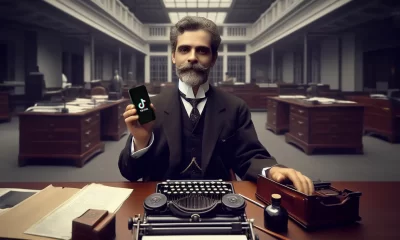Ted Lasso Effect: 5 Goal-Setting Secrets You Must Know
Uncover goal-setting wisdom from Ted Lasso: Embrace positivity, adaptability, and a balanced approach to personal and team goals in our latest post.

Imagine a world where your biggest leap of faith lands you in uncharted territory, much like stepping onto a soccer field when your only expertise is in American football.
This isn’t just a plot twist in a TV show; it’s the starting whistle of “Ted Lasso,” a series that masterfully juggles humor, heart, and the unexpected art of achieving goals.
Table of Contents
1. Embrace Optimism
But what if I told you that Ted’s journey isn’t just for the screens? It mirrors the bold moves we make in our own lives, when we step out of our comfort zones and onto the playing fields of our ambitions.
In a whirl of laughter and life lessons, “Ted Lasso,” an American football coach turned English soccer manager, teaches us that the playbook for success isn’t always conventional. His story is a vibrant tapestry of missteps, triumphs, and, most importantly, a relentless positivity that turns the tide in the most unpredictable ways. But here’s the kicker:
The essence of Ted’s story is found in everyday life, in the stories of countless individuals who dare to redefine what success means to them.
This blog post isn’t just about connecting the dots between a fictional coach and real-world achievements. It’s an exploration of how the ‘Ted Lasso Way’ is more than a series of plot points; it’s a blueprint for setting and smashing goals, whether you’re aiming to conquer the corporate world or mastering a new skill in your backyard.
Buckle up as we dive into the heartwarming, hilarious, and often surprising parallels between the world of Ted Lasso and our own adventures in goal setting.
In the playbook of Ted Lasso, the rules of the game are rewritten. Ted, a coach in unfamiliar territory, doesn’t set his sights on the typical coach’s dream of just tallying up wins. Instead, he places his bets on something far more intangible yet impactful: cultivating a positive team culture and nurturing individual character growth.
This might sound like a strategy concocted in a feel-good Hollywood script, but it’s a page taken straight out of real life’s guide to meaningful success.
Picture this: In a memorable scene, Ted hands out homemade biscuits to Rebecca, the team’s owner, not as a mere gesture of friendliness, but as a symbol of his commitment to building genuine relationships.
It’s a simple act, but it speaks volumes about his approach. It’s not about scoring goals on the field; it’s about scoring points in trust and camaraderie off the field.
This echoes the philosophy of great leaders and coaches in real life who understand that the foundation of any successful team lies in its unity and mutual respect, not just its trophy case.
Ted’s focus on individual growth is exemplified in his interactions with players like Jamie Tartt and Roy Kent. He doesn’t just see them as players in a game; he sees them as individuals with unique challenges and potentials.
Ted’s persistent efforts to break through Jamie’s arrogant facade and Roy’s gruff exterior are reminiscent of mentors who go the extra mile to uncover the true potential of their protégés.
In the real world, this is akin to a manager who prioritizes their team’s personal development, understanding that a team’s strength lies not just in skills, but in character and self-growth.
The Right Tool for Every Problem: A Lesson from My Facade

Have you ever looked at something in your life and thought, “I need to fix this, and fast”? Sometimes, it feels like we’ve found the perfect solution, but are we really using the right tool? Let me share a story that happened to me recently, and maybe you’ll see yourself in it too.
Table of Contents
A Quick Fix or the Right Approach?
It all started on a Saturday morning. I looked at the front of my house and saw the facade and windows covered in dirt.
The dust had built up, and the rain had left those ugly streaks, making my beloved home look anything but pleasant. It bothered me.
It wasn’t just about the appearance, but a reflection of the mess that somehow seemed to invade other areas of my life.
Then, an idea flashed in my mind like a beam of light cutting through fog: why not use my pressure washer? It was sitting there in the garage, just waiting for the right moment to shine.

“This will be perfect!” I thought. The power of the water would clean everything quickly and efficiently. I could already imagine myself finishing the job with a smile, seeing the facade sparkling in the sunlight.
An Unexpected Warning
I put the plan into action. I turned on the pressure washer, felt the power of the engine humming, and started aiming the jet at the facade.
The sound of water hitting the wall felt like the noise of change in motion: everything was going to be clean and in order. But suddenly, I heard my neighbor’s voice. He was standing on the other side of the fence, watching my excitement.
“Hey, are you sure that’s the best idea?” He smiled slightly, but there was a seriousness in his eyes. I was confused for a moment, so I turned off the machine, wanting to understand what she meant.

He continued, “The pressure washer is great, but the pressure is too strong for that facade. It might end up peeling off parts of it and cause more damage than fix the problem. Maybe it’s better to use it just on the windows.”
Rethinking the Plan
His words caught me off guard. I was so focused on the quick solution that I hadn’t thought about the consequences. I looked at the facade and imagined pieces of plaster falling off, which would make the situation far worse than it already was. He was right.
I was about to use the wrong tool for the job.
I turned off the pressure washer and, with a bit of frustration, grabbed a bucket, a brush, and some soap. It wasn’t the fastest method, but it was the right one. And as I carefully scrubbed the facade, I began reflecting on how often, in life, we do exactly what I was doing at that moment.
“Many times, we want to fix things quickly and easily, using the first tool we find. But the rush and the wrong choice can cause even greater damage.”
The Pressure of Solutions
Sometimes, the pressure we apply to solve something ends up hurting instead of healing. It’s like when we fight with someone we love, thinking that a harsh conversation full of accusations will fix everything, but in reality, we end up causing more pain.
Or when we face a problem at work and think that forcing a solution — without fully understanding the issue — will make everything better, but in truth, it only wears out relationships and makes things more complicated.
Just like I had to adjust my approach to the facade, we need to carefully choose the tools we use to solve the problems in our lives. Not every problem needs a high-pressure jet. Sometimes, all we need is a gentle brush and a bit of patience.
“Knowing how to choose the right tool for each situation is a form of wisdom. It prevents small problems from becoming big disasters.”
Learning to Be Gentle
And so, that day, I learned that sometimes the most obvious solutions aren’t the best ones. I learned that it’s not just about the power we have but about how and where we apply that power.
Sometimes, we need a pressure washer — something powerful, strong, and fast. But other times, we need a bucket and a brush — something that requires patience, delicacy, and time.

What About Your Facades?
So next time you find yourself facing a problem, think a little harder. Take a deep breath and ask yourself: “Am I about to use the right tool? Or am I applying too much force to something that needs careful handling?”
Who would have thought that the most important lesson of the day would come while scrubbing my dirty facade, right?
Now tell me: what are the “facades” in your life that you’ve been trying to clean? Maybe it’s time to change the tool, don’t you think?
9 Strategies to Develop a Growth Mindset

We’ve all faced moments when things didn’t go our way. Maybe you didn’t get the grade you wanted, missed a big opportunity, or faced a tough situation.
It hurts, doesn’t it? But here’s the thing: how you bounce back matters.
With a growth mindset after disappointment, you can flip the script. Instead of seeing failure, you see a chance to learn, grow, and improve.
It’s about taking that disappointment and turning it into fuel for something better.
“Disappointment is inevitable, but defeat is optional.” – Anonymous
Let’s look at 9 simple ways to build a growth mindset after disappointment and come back stronger.
Table of Contents
What is a Growth Mindset?
A growth mindset is like a muscle—you can strengthen it over time. People with this mindset believe they can improve through hard work, learning, and trying new things.
They don’t shy away from challenges; they embrace them.
On the flip side, a fixed mindset is when you believe your abilities are stuck—you’re either good at something, or you’re not. But that kind of thinking can trap you.
“In a growth mindset, challenges are seen as opportunities to grow, not as threats to competence.” – Carol S. Dweck
When you adopt a growth mindset after disappointment, you’re telling yourself, “I can get better.” You’re no longer afraid of failure because, to you, failure is just another way to grow.
9 Ways to Build a Growth Mindset After Disappointment
1. Acknowledge the Disappointment and Move Forward
First, let yourself feel the disappointment. It’s okay to be upset—it’s part of being human. But don’t stay stuck there. Acknowledge it, then make the decision to move forward.
“The first step to bouncing back is accepting that things didn’t go as planned, and that’s okay.” – Brené Brown
2. Reframe the Setback as a Chance to Learn
Instead of seeing the setback as a dead end, ask yourself, “What can I learn from this?” Turning a problem into a possibility is key to having a growth mindset after disappointment.
3. Focus on What the Experience Taught You
Even in disappointment, there’s always something to learn. Every experience, good or bad, has value. Find the lesson hidden inside, like a treasure buried beneath the sand.
4. Set Realistic New Goals
After disappointment, it’s easy to feel lost. But don’t give up. Instead, set new, achievable goals. Like climbing a mountain, sometimes you slip, but you keep going.
5. Embrace the Process Over Immediate Results
Success doesn’t happen overnight. That’s why embracing the journey is so important. Focus on how you’re growing, not how fast you’re getting there.
6. Surround Yourself with Supportive, Growth-Minded People
Surround yourself with friends, mentors, or family who believe in growth and encourage you to keep going.
“The people you surround yourself with can either lift you higher or pull you down. Choose wisely.” – John C. Maxwell
7. Focus on What You Can Control
Some things are out of our hands—like the weather, or someone else’s opinion. But you can control how you react. By focusing on what you can change, you take charge of your journey.
8. Practice Gratitude for What You’ve Learned
Practicing gratitude shifts your focus from what went wrong to what you’ve gained. Gratitude is key to a growth mindset after disappointment.
9. Celebrate Small Victories Along the Way
Every little win counts. Celebrate these small victories, and they’ll fuel your confidence and commitment to keep going.
How a Growth Mindset Helps You Overcome Disappointment
A growth mindset after disappointment helps you see the bigger picture. When you look at setbacks as temporary, you understand they’re part of the journey, not the end of it.
“I’ve failed over and over again. And that is why I succeed.” – Michael Jordan
Recommended Books to Build a Growth Mindset After Disappointment
Here are a few books that can guide you on your journey to developing a growth mindset after disappointment:
1. Mindset: The New Psychology of Success by Carol S. Dweck
This book explains the difference between a growth and fixed mindset and offers tools to shift your thinking.
2. Rising Strong by Brené Brown
Brené Brown dives deep into how we rise after falling. It’s a powerful read for anyone facing setbacks.
3. Grit: The Power of Passion and Perseverance by Angela Duckworth
Duckworth’s research shows how grit—combining passion and persistence—helps people succeed, especially after failure.
Conclusion
Disappointment isn’t the end of the road—it’s just a bend in the journey. Building a growth mindset after disappointment allows you to learn, grow, and come back stronger than ever.
So, start today. Embrace these simple strategies, and watch as your setbacks become stepping stones to a brighter, better future. Your growth begins now.
4 Insights from the Neuroscience of Motivation to Boost Your Personal Development

Ever wonder why some days you feel unstoppable while others you can barely get out of bed? The answer might be in your brain.
Recent studies in the neuroscience of motivation are shedding light on how our brains drive us to pursue goals, take action, and keep going even when the going gets tough.
Understanding these brain functions is changing the way we approach personal development, making it more effective and tailored to how our minds actually work.
By tapping into the science behind motivation, you can learn how to harness your brain’s natural wiring to stay driven, focused, and productive.
Whether you’re trying to build better habits, achieve long-term goals, or simply stay motivated day-to-day, insights from the neuroscience of motivation can be a game-changer.
Let’s dive into some of the most compelling discoveries and how you can apply them to boost your personal development.
Table of Contents
How Motivation Works in the Brain
Motivation starts in the brain, specifically in a part called the reward system. This system involves several brain regions, but the most important player is dopamine—a neurotransmitter often dubbed the “feel-good” chemical.
When you achieve something or even anticipate a reward, your brain releases dopamine, giving you that rush of satisfaction.
But here’s the twist: dopamine isn’t just about pleasure. It’s also about anticipation and drive. When your brain expects a reward, it releases dopamine to push you toward that reward, creating a powerful cycle of motivation.
This is why setting goals and visualizing success can be so effective—they trigger your brain’s reward system, making you more motivated to take action.
Recent studies in the neuroscience of motivation show that understanding how this system works can help us fine-tune our approach to personal development. By aligning our goals and actions with our brain’s natural processes, we can stay motivated and avoid the common pitfalls of burnout and procrastination.
The Role of Dopamine in Motivation
Dopamine plays a central role in the neuroscience of motivation. It’s not just about making you feel good; it’s about driving you to seek out rewards.
Think of dopamine as the fuel that powers your motivation engine. When your brain releases dopamine, it’s like hitting the gas pedal—it propels you forward, making you eager to achieve your goals.
One fascinating aspect of dopamine is that it’s released not just when you achieve something, but also when you anticipate achieving it. This means that the mere thought of accomplishing a goal can boost your motivation.
That’s why visualizing your success or breaking your goals into smaller, achievable steps can be so powerful. It keeps the dopamine flowing, which keeps you motivated.
Dopamine also plays a role in forming habits. When you repeatedly perform an action that leads to a reward, your brain creates a dopamine pathway, making it easier—and more automatic—to repeat that action.
This is why habits are so hard to break but also why they’re so powerful once established.
By understanding dopamine’s role, you can structure your goals and habits in a way that maximizes your motivation and keeps you moving toward success.
5 Reasons Why Marcus Aurelius Meditations Is Key to Personal Growth

Why Marcus Aurelius Meditations is a Timeless Guide for Personal Growth and Resilience
Have you ever felt like life’s challenges are too overwhelming?
You’re not alone.
Many people are turning to Marcus Aurelius Meditations for guidance.
This ancient Roman emperor and Stoic philosopher wrote “Meditations”, a book full of wisdom on how to stay strong, disciplined, and focused, even when life gets tough.
In today’s fast-paced world, the lessons from Marcus Aurelius Meditations are more relevant than ever. Let’s dive into why this ancient text continues to inspire and help people grow.
Table of Contents
The Life and Philosophy of Marcus Aurelius
Marcus Aurelius wasn’t just a Roman emperor; he was also a philosopher who believed in living a virtuous life. Born in 121 AD, Marcus faced many hardships, like wars and political troubles.

But instead of giving up, he turned to Stoic philosophy, which taught him to stay calm and in control, no matter what.
In his book, “Meditations”, Marcus Aurelius shared his personal thoughts and struggles.
He never meant for these writings to be published—they were his way of staying focused and disciplined during tough times.
Today, these private reflections, known as Marcus Aurelius Meditations, are like a treasure chest of wisdom, offering us advice on how to handle life’s ups and downs with grace and strength.
Key Themes in Meditations
Marcus Aurelius Meditations is packed with timeless ideas that can help anyone, no matter their age or background. Let’s look at some of the key themes that make this book so powerful.
1. Resilience in the Face of Adversity
One of the main messages in “Meditations” is that challenges are a natural part of life. Marcus teaches us to be resilient, accepting what we can’t change and focusing on what we can control.
This mindset helps us stay grounded, even when everything around us feels chaotic.
2. Self-Discipline and Control
Another important lesson from Marcus is the value of self-discipline. He believed in mastering our impulses and emotions, not letting them control us.

By staying disciplined, we can make better decisions and keep our cool, even when things get tough.
This isn’t about ignoring our feelings but responding to them thoughtfully.
3. Maintaining Perspective
Marcus also reminds us to keep things in perspective. He knew that our time on earth is short and that many of our worries aren’t as big as they seem.
By keeping this bigger picture in mind, we can avoid getting caught up in small problems and focus on what truly matters.
These themes show why Marcus Aurelius Meditations is such a powerful guide for anyone looking to live a better, more meaningful life.
Practical Lessons from Meditations for Personal Growth
The wisdom in Marcus Aurelius Meditations isn’t just for reading—it’s for living. Here’s how you can take these Stoic lessons and apply them to your life today.
1. Practice Acceptance
One of the most important lessons from “Meditations” is learning to accept things as they are. Instead of fighting against situations you can’t control, focus on how you can respond positively.
This practice not only reduces stress but also helps you take meaningful action.
2. Cultivate Mindfulness
Marcus Aurelius often wrote about the importance of being present and aware. By practicing mindfulness, you can become more in tune with your thoughts and actions, leading to better decisions and a more balanced life.
3. Embrace Adversity as an Opportunity
In “Meditations”, Marcus encourages us to see obstacles as opportunities. Instead of viewing challenges as setbacks, try seeing them as chances to grow and learn.
This shift in mindset can turn difficulties into powerful tools for personal development.
4. Focus on What You Can Control
A key Stoic principle in Marcus Aurelius Meditations is to focus on what you can control and let go of the rest. By applying this principle, you can direct your energy toward what really matters, leading to more peace and effectiveness in your life.
By integrating these lessons into your daily routine, you can use Marcus Aurelius Meditations to build a life of resilience, discipline, and perspective.
Why Meditations is Still Relevant Today
Marcus Aurelius Meditations might be ancient, but its lessons are timeless.
The book explores human nature and the challenges we all face, making it as relevant today as it was thousands of years ago.
In a world filled with uncertainty, the wisdom of “Meditations” offers a calming perspective. Marcus Aurelius reminds us that while we can’t control everything that happens to us, we can control how we respond.
This message is why so many people turn to Marcus Aurelius Meditations for guidance in personal growth and resilience.
As more people discover Stoic philosophy, the teachings of Marcus Aurelius Meditations are becoming more popular, showing up in books, podcasts, and even social media. This renewed interest highlights how powerful these ancient principles are in helping us navigate modern life’s complexities.
Recommended Reading: Books on Stoicism and Personal Growth
If Marcus Aurelius Meditations has piqued your interest, here are some other books that can deepen your understanding of Stoic philosophy and personal growth:

1. The Daily Stoic by Ryan Holiday
- This book offers daily insights and reflections from Stoic philosophers like Marcus Aurelius, making it easy to incorporate Stoic wisdom into your everyday life.
2. A Guide to the Good Life by William B. Irvine
- William Irvine’s modern take on Stoic philosophy provides practical advice on living a fulfilling life by applying Stoic principles, making it a perfect companion to “Meditations”.
3. How to Think Like a Roman Emperor by Donald Robertson
- Donald Robertson’s book explores the life and philosophy of Marcus Aurelius, offering strategies for applying Stoic wisdom to today’s challenges.
4. The Obstacle Is the Way by Ryan Holiday
- In this book, Ryan Holiday uses Stoic philosophy to show how obstacles can be turned into opportunities for success, offering inspiration for anyone facing challenges.
5. Stoicism and the Art of Happiness by Donald Robertson
- This comprehensive guide to Stoicism offers practical advice on how to use Stoic principles to achieve happiness and peace of mind, complementing the teachings of Marcus Aurelius Meditations.
These books build on the lessons of Marcus Aurelius Meditations and provide further insights into living a life of resilience and personal growth.
Conclusion
Marcus Aurelius Meditations isn’t just a book—it’s a guide to living a stronger, more resilient life. The wisdom in “Meditations” offers practical lessons on how to stay calm, disciplined, and focused, no matter what life throws your way.
So, why not start today?
Whether you’re dealing with personal challenges, looking to improve your self-discipline, or simply want to keep a better perspective on life, Marcus Aurelius Meditations can help.
Embrace the wisdom of Marcus Aurelius and let it guide you toward becoming the best version of yourself.
-

 AI & Future Trends10 months ago
AI & Future Trends10 months agoAI in Time Management 2024: A New Era of Productivity for Business Leaders
-

 Personal Growth & Mindset6 months ago
Personal Growth & Mindset6 months agoMachado de Assis: This Viral TikTok Explains Why You Need to Read ‘The Posthumous Memoirs of Brás Cubas’ Now
-

 Career & Success11 months ago
Career & Success11 months ago30 Key Strategies for Growth: Mindset, Productivity & Wellness
-

 Career & Success6 months ago
Career & Success6 months agoChallenges of Not Having Goals: 5 tips to help you get started
-

 Personal Growth & Mindset11 months ago
Personal Growth & Mindset11 months agoBreaking Free from the Shackles of Bad Habits: 5 books to help you
-

 Personal Growth & Mindset11 months ago
Personal Growth & Mindset11 months ago5 Lessons from the Garden of the mind: Cultivating Mindfulness and Growth





























John
December 31, 2023 at 11:43 am
It is wonderful show ❤️. I will miss Ted Lasso way to deal with adversity.
Pingback: Teenage Emotions: Pixar's Masterful Exploration in Inside Out 2 | Growth Journey Hub
Pingback: 5-Minute Guide: Daniel Goleman's Take on Emotional Intelligence | Growth Journey Hub
Pingback: 5 Strategies for Navigating Hybrid Work Environments: Succeeding in a New Era of Work | Growth Journey Hub
Pingback: 7 Reasons Why Random Acts of Kindness Are More Powerful Than You Think | Growth Journey Hub
Pingback: AI in Time Management 2024: A New Era of Productivity for Business Leaders | Growth Journey Hub
Pingback: 9 Powerful Ways to Build a Growth Mindset After Disappointments and Setbacks | Growth Journey Hub
Pingback: This Feels Illegal to Know: The Best 7 Meditation Apps for 2024 - Growth Journey Hub
Pingback: 30 Key Strategies for Growth: Mindset, Productivity & Wellness - Growth Journey Hub
Pingback: Marriage Counseling Strategies Revealed: Top 24 Tips - Growth Journey Hub
Pingback: Overcoming Imposter Syndrome: Building Confidence in Your Career - Growth Journey Hub
Pingback: AI Motivation: Your New Superpower for Crushing Goals 2024 - Growth Journey Hub
Pingback: Challenges of Not Having Goals: 5 tips to help you get started - Growth Journey Hub
Pingback: Machado de Assis: This Viral TikTok Explains Why You Need to Read 'The Posthumous Memoirs of Brás Cubas' Now - Growth Journey Hub